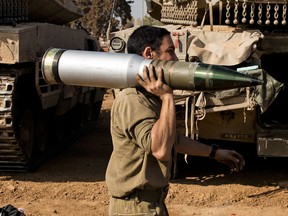Iran vowed revenge on Israel after the assassination of key Hamas leader Ismail Haniyeh in Tehran
Article content
Iran has vowed retaliation against Israel for the assassination of Hamas political leader Ismail Haniyeh, who was killed last week in Tehran. Senior Iranian officials told Reuters that only a ceasefire deal in Gaza would convince Tehran to hold back from direct retaliation against Israel.
Israel has not confirmed or denied its involvement in the assassination. Just days before Haniyeh was killed, Israeli armed forces killed senior Hezbollah commander Fuad Shukr, who was responsible for a missile attack on a soccer field in Israel’s Golan Heights that killed 12 children.
Advertisement 2
Article content
In response, both Iran and its Lebanon-based militia group, Hezbollah, vowed to retaliate.
The Israeli prime minister has warned Iran and Hezbollah of a “heavy price” for any aggression. “We are striking our enemies and are determined to defend ourselves,” Benjamin Netanyahu said.
Diplomatic efforts by Arab countries and the U.S. are ongoing, with hoped-for talks this week on the potential Gaza ceasefire, but if Iran does strike Israel, the situation could escalate into a direct conflict after decades of shadow wars.
As the region braces for potential conflict, here’s a look at the military power of Iran and Israel.
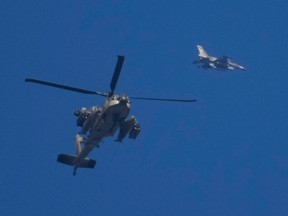
Israel
Military Personnel
The Israel Defense Forces (IDF) has over 169,000 active personnel, including its navy and paramilitary forces, according to the 2023 Military Balance report by the International Institute for Strategic Studies (IISS). The IDF also has roughly 465,000 reservists, with around 300,000 reserves called up after the October 7 Hamas terror attack.
Military service is compulsory in Israel for those over the age of 18, with men serving 32 months and women 24 months.
Advertisement 3
Article content
Air Power
Israel boasts the most advanced air power in the Middle East, thanks to its cutting-edge fighter jets and sophisticated drones.
According to the IISS, the IDF has 339 combat-capable aircraft, including 309 ground-attack aircraft. This fleet includes: 196 F-16 jets, 83 F-15s and 30 F-35s.
The American-made F-35 fighter jet is the most advanced in the world, equipped with cutting-edge sensors and communication systems. It can evade enemy detection, penetrate contested airspace, locate and track targets, jam radar, and disrupt attacks. Israel reportedly first deployed the F-35 in 2018 against Iran-backed militias in Syria.
Israel also has 142 helicopters, including 41 Apache attack helicopters. These helicopters are equipped with nose-mounted sensors for target acquisition and night vision capabilities.
In modern aerial warfare, drones play a crucial role. Israel has developed a range of sophisticated drones, including the Heron, Hermes, and Skylark series.
The Heron TP can fly more than 1,000 kilometres, with an endurance of over 30 hours. It is potentially capable of carrying a Rafael Spike anti-tank missile.
Article content
Advertisement 4
Article content
The Hermes 450 and 900 also have an endurance of over 30 hours. The former can fly 300 km, and the latter more than 1,000 km. They can carry four Rafael Spike guided missiles.
Skylark is a hand-launched drone with a range of 20 to 40 km that provides a real-time video feed.
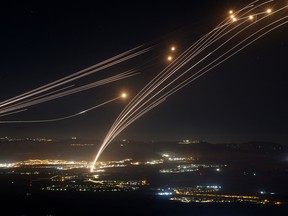
Air defence
Israel developed its first air-defence system, the Iron Dome, in 2006, following its war with Hezbollah, during which thousands of rockets were fired into Israeli territory. The Iron Dome is a mobile defence system designed to intercept short-range missiles, primarily from Hamas in Gaza and Hezbollah in Lebanon.
Other layers of Israel’s air defence include: David’s Sling, which protects against medium- to long-range threats; Arrow 2, which was co-designed with the U.S. and intercepts short- to medium-range ballistic missiles; and Arrow 3, which targets tactical ballistic missiles.
According to the IISS, Israel has Jericho missiles and aircraft capable of carrying nuclear warheads.
Nuclear
Israel is believed to possess dozens of nuclear warheads, though the country has never officially acknowledged this.
Advertisement 5
Article content
According to the Stockholm International Peace Research Institute (SIPRI), as of January 2024, Israel is estimated to have “a stockpile of around 90 nuclear warheads.”
In its annual report on global armaments and military spending, SIPRI notes that “approximately 30 of Israel’s nuclear weapons are estimated to be gravity bombs, likely deliverable by F-16 and F-15 aircraft.” While the U.S. and some NATO countries have assigned nuclear missions to F-35 jets, it is unclear whether Israel has done the same, the report adds.
Published in June 2024, the report also indicates that up to 50 warheads are thought to be assigned for delivery by Jericho, a land-based missile. Israel has never publicly acknowledged possessing these capabilities.
Israel operates five German-made Dolphin-class submarines, which are based off the Mediterranean coast. According to SIPRI, “There are unconfirmed reports that all or some of the submarines have been equipped to launch an indigenously produced nuclear-armed sea-launched variant of the Popeye cruise missile, giving Israel a sea-based nuclear strike capability.”
Advertisement 6
Article content
Ground and sea
On land, Israel has over 2,200 tanks. In its naval fleet, Israel possesses five submarines and 49 coastal and patrol combatants.
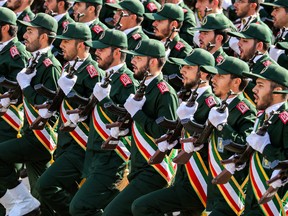
Iran
Military Personnel
Iran has the largest armed forces in the Middle East. According to the IISS report, the authoritarian regime maintains 580,000 active personnel and 200,000 trained reservists, split between its regular army and the powerful paramilitary force known as the Islamic Revolutionary Guards Corps (IRGC).
Military service is mandatory for men over the age of 18, with Iran requiring two years of service in either the army or the IRGC.
Iran also has an elite unit, the Quds Force, which is responsible for training and funding Tehran’s proxy groups across the region, including in Iraq, Syria, Lebanon, Gaza and Yemen.
Air Power
Iran’s fighter fleet is aging, with much of its current inventory dating back to the 1970s, when it was acquired by the former monarch, King Mohammad Reza Pahlavi, from the U.S. Due to a lack of parts and continued sanctions by the U.S. and other Western nations, Iran has increasingly relied on domestically produced missiles and drones in recent years.
Advertisement 7
Article content
According to the IISS, Iran has nine squadrons of F-4 and F-5 fighter jets, one squadron of Russian-made Sukhoi-24 jets, and some F-14 and MiG fighter jets.
Despite its outdated fleet, Iran has one of the largest ballistic missile and drone arsenals in the region. The country has produced thousands of missiles, including ballistic missiles with ranges of up to 2,000 kilometres, capable of reaching Israel.
Among its advanced drone technology, Iran’s Shahed-136 is particularly notable, with a range of up to 2,400 kilometres. The Shahed-129 has an estimated range of 1,700 kilometres. Recently, Tehran unveiled a suicide drone, yet to be named, capable of carrying a six-kilogram payload with a range of 40 kilometres.
Iran is also a significant exporter of drones, supplying them to Russia for use in Ukraine, as well as to its proxies, such as Lebanon’s Hezbollah and Yemen’s Houthis, as well as to Sudan.
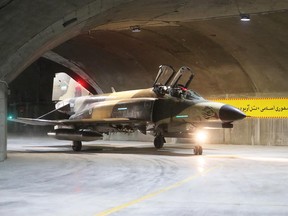
Air Defence
Due to military sanctions, Iran has relied primarily on Russian-made S-300 anti-aircraft systems. It has also developed its own air defence systems. In 2022, Iran unveiled the Bavar-373, which has radar detection capabilities up to 450 kilometres and can carry Sayyad surface-to-air missiles.
Advertisement 8
Article content
Iran has also developed medium-range air defence systems, including the Arman, Tactical Sayyad and Khordad-15.
Other Capabilities
At sea, Iran has developed high-speed military boats and a number of small submarines, primarily patrolling the Persian Gulf.
Iran has also been pursuing secret nuclear activities. Tehran denies it is trying to build a nuclear bomb, but has developed more uranium than what was allowed in a U.S.-brokered deal in 2015.
Recommended from Editorial
Article content

